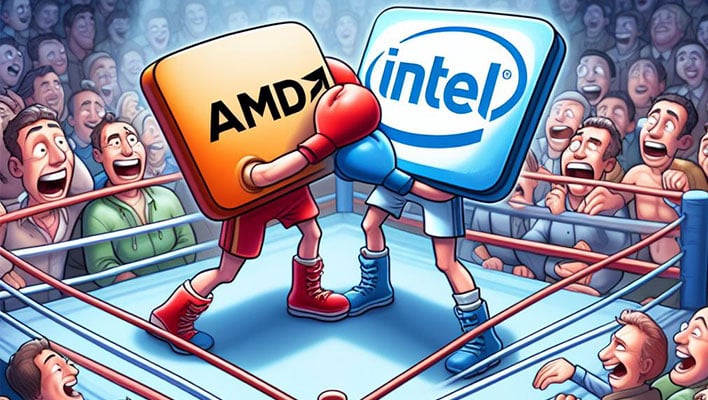AMD Takes More Of Intel's Lunch Money In Desktop And Server CPU Share

There have been some epic fights over the years, such as Sugar Ray Leonard clashing with Thomas Hearns, Muhammad Ali knocking out George Foreman, and Buster Douglas defeating Mike Tyson in a shocking upset, to name a few. One of the longest-running grudge matches, however, is between AMD and Intel. It's too early to declare AMD the modern-day Buster Douglas of tech, but it is getting in some impressive jabs, having knocked loose some more desktop and server CPU share from its heavyweight rival.
Boxing puns aside (excuse us, it's Friday and we're feeling a bit punchy), the latest market share data comes courtesy of Dean McCarron, president of Mercury Research. In an emailed note, McCarron highlighted x86 processor shipment trends in the first quarter of 2024 (on the heels of a pandemic hangover), with all segments declining moderately on quarter, which is line with typical seasonal trends.

Source: Mercury Research
There are a lot of data points to digest, but one of the more interesting ones is the breakdown of desktop CPU shipments. AMD managed to pick Intel's pocket and increase its desktop CPU market share to 23.9%, compared to 19.8% in the previous quarter and 19.2% in the same quarter a year ago. Intel is still way out ahead with a 76.1% share of the desktop market (which excludes IoT), but that's down from 80.2% just a few short months ago.
According to McCarron's audit, AMD's desktop CPU shipments were nearly flat, which is actually far better than what's typical this time of the year.
"AMD's strong desktop showing in a typically steeply down quarter resulted in a relatively large on-quarter and on-year share increase for the first quarter. For AMD the strength in desktop was due to surprisingly strong Vermeer core shipments and the ramp of the new desktop version of the Phoenix Point APU," McCarron said.
McCarron also noted that Intel's 14th Gen Raptor Lake Refresh CPUs had a strong ramp in the first quarter, but since the new chips were replacing 13th Gen parts that are also based on Raptor Lake, "there was no upside to the ramp."

Source: Mercury Research
The other area where AMD gained some ground on its rival is in servers. Both AMD and Intel saw declines in server CPU shipments in line with typical seasonality trends, but AMD managed to nudge its share up to 23.6%, up from 23.1% last quarter and 18% a year ago. As a result, Intel's share fell slightly to 76.4%, down from 76.9% a quarter a ago and 82% from Q1 2023.
"AMD's share is
up significantly on year, and AMD's server CPU unit shipments were
also up on year v. Intel's declines. The suppliers didn't provide
much insight into server CPU dynamics in their earnings
discussions, but for AMD it was apparent that Genoa is the main
driver of on-year growth," McCarron said.
That's a big deal as the server sector is a lucrative one with higher margins. It's also especially important for AMD to notch these kinds as wins, as they come during a big decline in SoC shipments resulting from decreased console demand—AMD's custom processors are what power Sony's PlayStation 5 and Microsoft's Xbox Series X|S consoles.

Source: Mercury Research
While Intel staggered a bit in desktop and server shipments compared to AMD, it managed to increase its share in mobile, at least compared to the previous quarter—Intel's mobile CPU share rose sequentially from 79.7% to 80.7%, versus AMD's slipping from 20.3% to 19.3%.
"Intel did gain share in mobile client in the first quarter, as it
continued to ramp Raptor Lake cores (while Meteor Lake ramped as
well, it was off a tiny base in the prior quarter and the ramp was
slower than expected. Intel noted in their earnings call that
packaging capacity was a limiting factor in Meteor Lake's
shipments)," McCarron said.
AMD's mobile shipments, on the other hand, declined to a greater degree than Intel, particularly with regards to its "oldest mobile CPU cores," resulting in the loss of share during the first quarter.
Looking at the overall x86 picture (all CPUs, including IoT and SoCs), Intel continues to dominate, having increased its share to 73.9% (up sequentially from 71.4%), while AMD settled in at 26.1% (down sequentially from 28.6%).
Top image source: Microsoft Copilot via Designer

